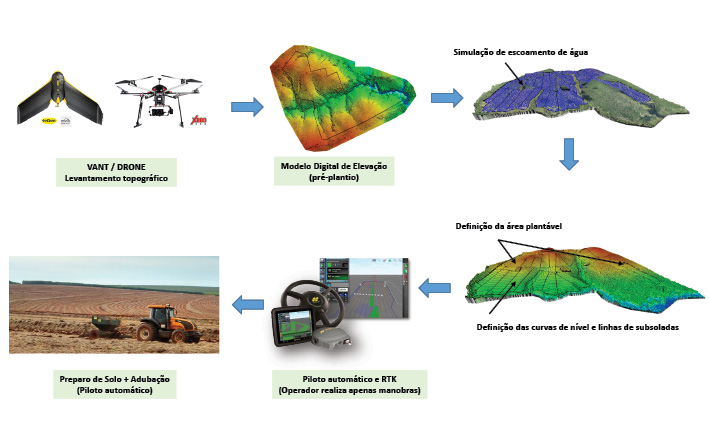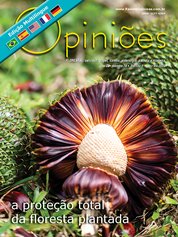João Leonardo Miranda Bellotte, Sharlles Christian Moreira Dias e Frederico Alfenas Silva Valente
Especialista de Nutrição, Gerente de Tecnologia e Coordenador de Nutrição da Eldorado Brasil Celulose
OpCP70
Tecnologia de preparo e conservação de solos arenosos
O Mato Grosso do Sul tem se destacado na expansão de florestas plantadas de eucalipto para fornecer matéria-prima para as indústrias de celulose, desde as já implantadas até os projetos de expansão do setor de celulose na região. A eucaliptocultura no estado já ultrapassa um milhão de hectares e concentra-se na costa leste do MS, que apresenta, hegemonicamente, solos de baixa aptidão agrícola, com predominância de textura arenosa e grande suscetibilidade à erosão. Nessa região, as plantações de eucalipto têm ocupado, notadamente, áreas anteriormente cultivadas com pastagens, muitas em estágios de degradação avançadas.
A condição climática na região caracteriza-se pelo inverno seco e verão chuvoso, com precipitação média anual em torno de 1.200 mm e temperaturas médias de 25 °C. Além disso, observa-se que eventos climáticos extremos, como tempestades e ventos fortes, têm ocorrido com maior frequência, favorecendo os processos erosivos do solo.
A condição climática na região caracteriza-se pelo inverno seco e verão chuvoso, com precipitação média anual em torno de 1.200 mm e temperaturas médias de 25 °C. Além disso, observa-se que eventos climáticos extremos, como tempestades e ventos fortes, têm ocorrido com maior frequência, favorecendo os processos erosivos do solo.
A região encontra-se sob o domínio do bioma de Cerrado e apresenta solos intemperizados, profundos, predominantemente arenosos e com baixa fertilidade natural. A textura arenosa está associada a materiais de origem formados por arenitos quartzosos. A região da Costa Leste do Mato Grosso do Sul apresenta 78% das áreas com teores de argila abaixo de 15% (limite para classificar os solos em arenosos). De maneira generalizada, predominam os neossolos quatzarênicos e latossolos vermelhos.
 Solos mais argilosos possuem maior capacidade de armazenamento de água (CAD), maior capacidade de troca catiônica (CTC) e menor risco de erosão, comparativamente aos solos arenosos, portanto a textura assume grande importância no manejo sustentável do sistema. Geralmente o manejo conservacionista do solo é iniciado na etapa de prospecção de terras, cujo objetivo é avaliar a aptidão dos imóveis para os plantios florestais. Essa avaliação considera, de maneira preliminar, três importantes variáveis: textura do solo, impedimento físico ao crescimento radicular e produtividade florestal.
Solos mais argilosos possuem maior capacidade de armazenamento de água (CAD), maior capacidade de troca catiônica (CTC) e menor risco de erosão, comparativamente aos solos arenosos, portanto a textura assume grande importância no manejo sustentável do sistema. Geralmente o manejo conservacionista do solo é iniciado na etapa de prospecção de terras, cujo objetivo é avaliar a aptidão dos imóveis para os plantios florestais. Essa avaliação considera, de maneira preliminar, três importantes variáveis: textura do solo, impedimento físico ao crescimento radicular e produtividade florestal.Áreas muito arenosas, com presença significativa de cascalho ou solos hidromórficos (sujeitos à inundação) e com baixa expectativa de produtividade, são consideradas inaptas ao plantio. Essa avaliação das características físico-químicas do solo, de forma prévia ao arrendamento/aquisição de terras, promove uma abordagem integrada do manejo, disponibilizando informações para o preparo conservacionista que será empregado nas próximas etapas do processo produtivo.
As empresas vem utilizando tecnologias de mapeamento prévio com VANTs e drones, além de tecnologia avançada de SIG (Sistema de Informações Geográficas) para o planejamento, a definição e a construção das estradas e dos carreadores, a definição de alinhamento de plantio e de linhas de subsolagem.
As estradas e os aceiros são construídos respeitando a declividade do terreno, de forma que o talhonamento da fazenda esteja disposto em forma de “espinha-de-peixe” (ângulo entre 45° ou 60° em relação às estradas principais). Essa disposição tem por finalidade garantir a trafegabilidade e manobras das carretas no momento do transporte de madeira. Outra prática conservacionista do solo é a construção das “minicurvas” para drenagem das águas pluviais das estradas e dos aceiros para o interior dos talhões, permitindo a infiltração da água de forma gradual e sem risco de erosão.
As “minicurvas” são constituídas por um camalhão posicionado na estrada, perpendicularmente a ela, com uma ou duas saídas de água que se estendem para dentro do talhão em uma distância de 35 m. Essas estruturas são construídas a cada 3 m de desnível do terreno.
O preparo de solo tem como principal objetivo oferecer condições adequadas para o estabelecimento e crescimento das mudas. Para isso, o solo é descompactado mecanicamente a partir de uma haste subsoladora e um conjunto de grades (subsolagem). Na mesma operação, é realizada a aplicação de fertilizantes em profundidade. As condições predominantes de relevo plano a suave ondulado na região, com declividade inferior a 8%, favorecem a realização dessas operações mecanizadas.
A aplicação da tecnologia RTK (Real Time Kinematic) + piloto automático é importante para realização da subsolagem. Com essa tecnologia, a precisão entre as linhas planejadas em escritório versus linhas executadas em campo é de até 5 cm, garantindo a repetibilidade, o paralelismo e a qualidade dos serviços realizados.
Previamente ao uso da tecnologia RTK, são realizados levantamentos topográficos por VANTs ou drones para recriar a paisagem tridimensionalmente e simular o escoamento superficial de água a partir de modelos digitais de elevação. As linhas de plantio são planejadas e traçadas em escritório, de modo perpendicular ao escoamento de água dos talhões, visando favorecer a infiltração de água no solo e minimizar os processos erosivos.
O preparo de solo realizado é pautado no conceito de cultivo mínimo, onde apenas a faixa que irá receber as mudas é preparada. Nesse modelo, preconiza-se a manutenção dos resíduos vegetais na entrelinha do cultivo (podendo ser o resíduo florestal do ciclo anterior ou da pastagem/cana em casos de implantação), de maneira a revolver o solo o mínimo possível, buscando o equilíbrio entre as fases química, física (proteção contra erosão e aumento do armazenamento de água) e biológica do solo (favorecer a comunidade de microrganismos).
Ao longo dos anos, o manejo do solo evoluiu a partir da extensão de resultados da rede experimental. A partir dos conhecimentos adquiridos, foi possível definir preparos do solo entre 40 e 50 cm de profundidade e 80 cm de estrondamento lateral, priorizando o preparo em solos mais argilosos para o período chuvoso, de maneira a coincidir com a consistência friável do solo e, assim, minimizar a formação de torrões e maximizar a sustentabilidade/conservação do sistema.
Além das boas práticas de preparo de solo realizadas, em solos arenosos, recomenda-se o processo de colheita florestal cut-to-lenght (CTL), em que apenas o lenho das árvores é exportado da área produtiva, e os demais compartimentos, casca, galhos, folhas e serrapilheira, permanecem na superfície do solo e contribuem para a manutenção da fertilidade dos solos, reduzem a exposição direta aos raios solares, promovem o aumento da retenção de água no solo e minimizam os efeitos das erosões e da compactação do solo decorrentes das operações mecanizadas subsequentes.
A adoção de técnicas conservacionistas de preparo e uso do solo são fundamentais para a preservação dos solos e a manutenção da capacidade produtiva dos sítios ao longo dos ciclos. As tecnologias embarcadas vieram para ficar e são ferramentas valiosas para garantir a execução conforme planejamento e promover o menor impacto possível das operações silviculturais sobre o recurso que sustenta a produção florestal, o solo. Portanto, para garantir “a proteção total das florestas plantadas”, o manejador florestal deve proteger o recurso que as sustenta, o solo, e isso passa pelo uso das técnicas conservacionistas, porém com ferramentas tecnológicas.
A adoção de técnicas conservacionistas de preparo e uso do solo são fundamentais para a preservação dos solos e a manutenção da capacidade produtiva dos sítios ao longo dos ciclos. As tecnologias embarcadas vieram para ficar e são ferramentas valiosas para garantir a execução conforme planejamento e promover o menor impacto possível das operações silviculturais sobre o recurso que sustenta a produção florestal, o solo. Portanto, para garantir “a proteção total das florestas plantadas”, o manejador florestal deve proteger o recurso que as sustenta, o solo, e isso passa pelo uso das técnicas conservacionistas, porém com ferramentas tecnológicas.




